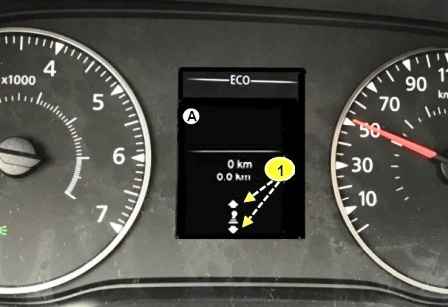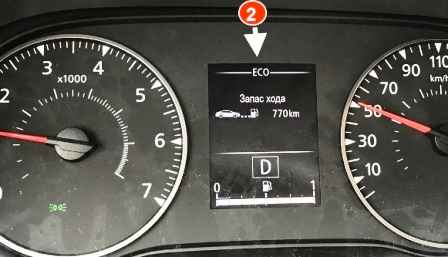Control mode fuel consumption by the standard approved method.
This method is used by all manufacturers and allows you to compare cars with each other.
Actual fuel consumption will vary depending on vehicle usage, equipment and driving style.
The following are recommendations for optimizing fuel consumption.
Depending on the equipment, the car can be equipped with a number of functions to control and reduce fuel consumption:
- - tachometer;
- - gear change indicator;
- - ECO mode. activated by the ECO button.

Shift indicator 1

In order to optimize fuel consumption, signal lamps on the instrument panel "A" inform you of the best moment to shift up or downshift;
ECO mode is a function to optimize fuel consumption
It is used to correct some of the vehicle's energy-intensive systems (heating, air conditioning, power steering, etc.) and for some adjustments while driving (acceleration, gear shifting, cruise control, deceleration, etc.)
Limiting the intensity of acceleration allows you to reduce fuel consumption in urban and suburban traffic.
When the ECO mode is on, it is normal to change the heating mode
Enabling the ECO function

Press switch 3

Illumination of the 2 ECO warning light on the instrument panel "A" confirms the activation of this mode
While driving, you can temporarily exit the ECO mode and use the full engine power. To do this, you need to press the gas pedal hard and all the way
ECO mode will automatically turn on when you release the gas pedal
Disabling the ECO system
Press switch 3
The 2 ECO warning light will go out on the instrument panel when the mode is switched off
Driving tips and ECO driving mode
Behavior:
- - careful driving at low speed until the engine is fully warmed up, preferably warming up the engine at idle in the parking lot;
- - dynamic driving with frequent acceleration and deceleration will lead to increased fuel consumption, which is unlikely to pay off by saving time;
- - do not press hard on the gas pedal while driving in intermediate gears. Try to always use the highest possible gear;
- - don't accelerate too fast;
- - do not try to maintain the same speed when driving on slopes; do not press the accelerator pedal more than when driving on a level road: keep your foot on the accelerator pedal in the same position;
- - double declutching and "re-gassing" when shifting gears before stopping the engine is completely unnecessary on modern cars;
- - in a car with an automatic transmission, it is preferable to always put the gear selector lever in position D when driving
Tires:
- - too low air pressure in tires contributes to increased fuel consumption;
- - fitting tires other than those recommended by the manufacturer may also lead to increased fuel consumption
Hints for use:
- - try to use ECO mode;
- - electricity consumption leads to an increase in fuel consumption, so always turn off unnecessary electrical appliances. For safety reasons, leave your headlights on when visibility is poor (to see and be seen);
- - use standard interior ventilation system. At a speed of 100 km/h, driving with the windows open increases fuel consumption by 4%
- - do not overfill the tank when refueling to avoid spilling fuel;
- - on vehicles with air conditioning, when using air conditioning, an increase in fuel consumption is observed, especially when driving in urban traffic. In vehicles without automatic mode, turn off the air conditioner when not needed





